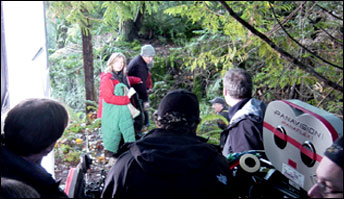A painting in an art gallery window - Lee Teter's "Reflections," depicting spectral soldiers at the Vietnam Wall - brought the question back to mind. Miller's answer took the form of Jake Neeley, scarred by the memory of a jungle 'hooch,' the smiling faces of children, and the shock of sudden death.
 When
Miller contacted Gabrielle Savage Dockterman, she had been looking for
some time for "the right vehicle" for her feature directing
debut. She had already compiled such impressive multimedia credits as
the New York Film Festival Award winner, "The Great Solar System
Rescue," and "Minds - On Science," commissioned as part
of the largest permanent exhibit in the history of the Smithsonian Institution.
"Rainforest Researchers," developed
with scientists at Harvard University, had taken her to a remote island
off the coast of Sumatra where for thousands of years tribal shamans have
treated the sick with plants and herbs that are only recently being recognized
by modern medicine. The CD-ROM series won scores of honors including the
prestigious Codie Award, the ITVA Golden Reel and a Parent's Choice award.
When
Miller contacted Gabrielle Savage Dockterman, she had been looking for
some time for "the right vehicle" for her feature directing
debut. She had already compiled such impressive multimedia credits as
the New York Film Festival Award winner, "The Great Solar System
Rescue," and "Minds - On Science," commissioned as part
of the largest permanent exhibit in the history of the Smithsonian Institution.
"Rainforest Researchers," developed
with scientists at Harvard University, had taken her to a remote island
off the coast of Sumatra where for thousands of years tribal shamans have
treated the sick with plants and herbs that are only recently being recognized
by modern medicine. The CD-ROM series won scores of honors including the
prestigious Codie Award, the ITVA Golden Reel and a Parent's Choice award.
Dockterman optioned the story that would become Missing In America, and for the next two years, she, Miller and co-writer Nancy L. Babine engaged in what she calls "an unusual and wonderful collaboration," working together almost entirely by e-mail.
"That was before 9/11 and the invasion of Iraq. There was no way for us to know how timely the script would eventually become." They were well aware, though, of the challenge of funding an unconventional story with a first-time director in a tight economy. Enter Isen Robbins and Aimee Schoof whose youthful production partnership, Intrinsic Value, had compiled an extraordinary record - some fourteen independently financed feature films which had navigated festivals and specialized release with success. "The real challenge isn't raising the money, as tough as that is. It's using the money to make a good movie, even if - as usual - you don't have enough," says Robbins. "With MIA, it became a kind of a holy war. Here was this spiritual, magical, beautifully told story. It demanded a brilliant actor in the lead role. So we made up a wish list of people we probably couldn't get. And instead we got lucky. Our first choice said yes." "I was fascinated by the story," recalls Danny Glover. "This is the sort of work, as an actor, that you always hope to find, where the action is motivated by emotional danger as opposed to physical danger." That begins, he continues, with his character's first glimpse of Lenny."In Vietnam, Jake Neeley had to make the choice between endangering his men and murdering children. The children are innocent. They're what the desk soldiers, behind the lines, call 'collateral damage.' He has lived with the nightmare of his decision for more than 30 years and when this little girl enters his cabin, it all comes flooding back in the most visceral way."
